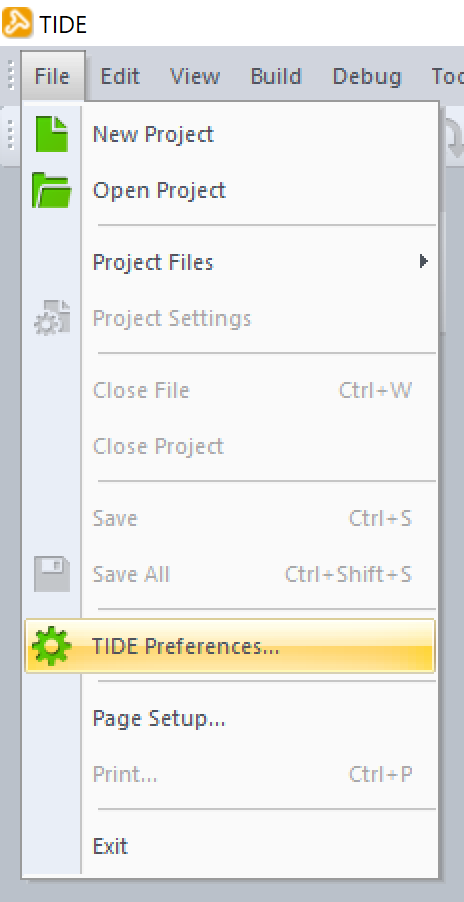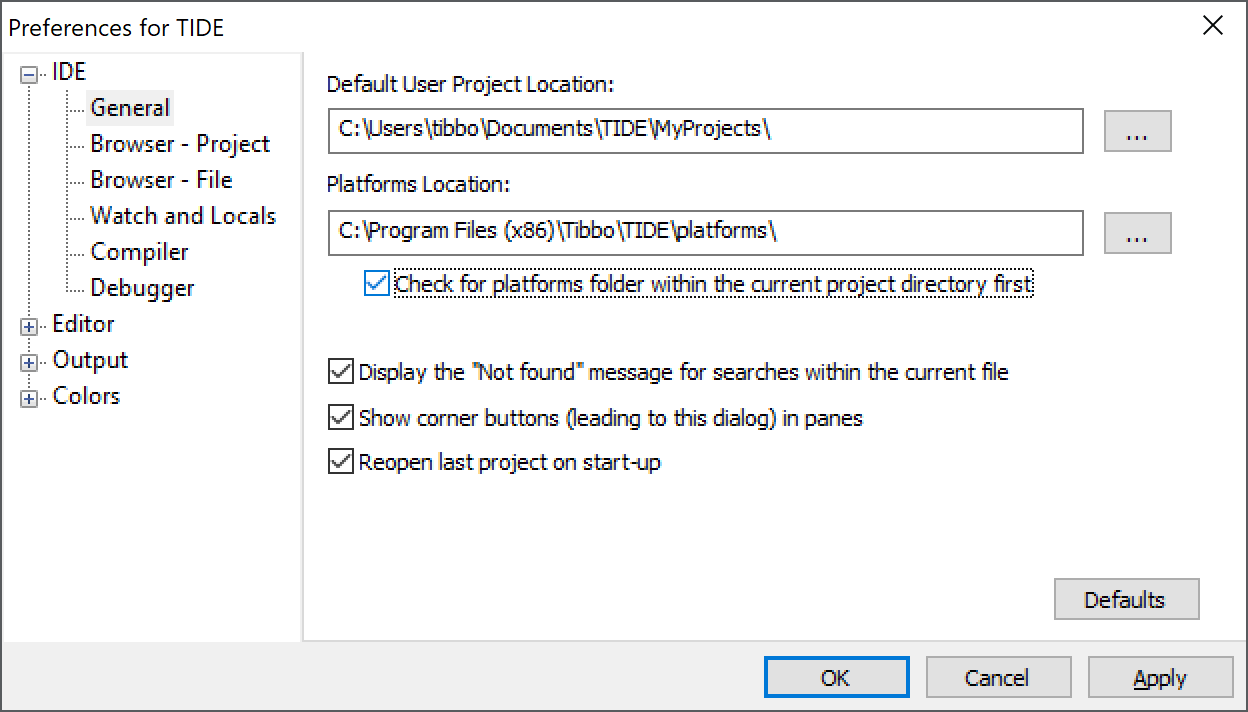This repository contains the official demonstration projects that showcase the features of Tibbo's WM2000 programmable wireless IIoT module (product page | documentation) in conjunction with the WM2000EV evaluation board (product page | documentation).
Each project consists of a Tibbo BASIC application and includes all of the necessary files for compilation in Tibbo IDE (TIDE). When opening these projects in TIDE, make sure to enable the "Check for platforms folder within the current project directory first" option inside the TIDE Preferences, as illustrated below.
This ensures that each application uses its included libraries. Also included in the platforms folder is the firmware version that the device is intended to use for this project.
The WM2000 is a "wireless-first" IIoT module that is programmable in Tibbo BASIC and Tibbo C. It features Wi-Fi (802.11a/b/g/n over 2.4GHz/5GHz) and Bluetooth Low Energy (BLE) interfaces that support automatic network association, wireless debugging, over-the-air (OTA) updates, secure sockets through Transport Layer Security (TLS), and other functionality. The module incorporates two high-speed serial ports, I²C/SPI ports, onboard flash and EEPROM, a real-time clock that enables a low-power mode, and 10 GPIO lines.
The WM2000EV is a board for evaluating the WM2000. It provides the minimum hardware required to test out the WM2000's various features, including pulse-width modulation (PWM), Wi-Fi and BLE connectivity, and the low-power mode. The board also facilitates connecting external hardware to each of the module's pins and measuring the current consumption of the board and/or module via dedicated terminals. It can be powered via an integrated USB Type-C connector or a two-pin terminal block connector for 3V-5.5V power input.
The projects included in this repository constitute the software side of Tibbo's curated journey of exploration for the WM2000EV.
This application is pre-loaded at the factory on the WM2000 that is included in each WM2000EV kit. The project requires absolutely no coding by the user and demonstrates how quick and straightforward the configuration of the WM2000 as an IIoT sensor node can be. In as little as 5 minutes, your WM2000 will be securely transmitting sensor data to a nonaffiliated, third-party cloud services provider — Keen, in this case.
This project demonstrates the following functionality of the WM2000:
- Using L.U.I.S. (Loadable User Interface System) to configure the device over BLE
- Automatic association with a Wi-Fi network
- Scheduled, redundant, and secure data transmission through TLS
- Polling the built-in light and temperature sensors
- Storing data in the integrated flash disk
- Time synchronization
- Playing patterns of light through the integrated RGB LED
Detailed, step-by-step instructions for using this application are available at Tibbo Docs.
This application showcases how the WM2000's pulse-width modulation (PWM) capabilities can be used to control the color output of the WM2000EV's RGB LED through a web-based interface.
This project demonstrates the following functionality of the WM2000:
- Using L.U.I.S. to configure the device over BLE
- Automatic association with a Wi-Fi network
- Dual applications
- Wireless debugging
- Controlling the RGB LED's output by manipulating its three control lines with PWM
- Using a built-in web interface to provide real-time control over the module
Detailed, step-by-step instructions for using this application are available at Tibbo Docs.
This application demonstrates the WM2000's ability to securely transmit data to leading cloud services provider Microsoft Azure, as well as receive commands to control the WM2000EV's built-in RGB LED. Two-way communications are crucial for implementing IIoT and industrial automation solutions.
This project might require a firmware update due to a new API method. For your convenience, we have made available a Tibbo Composite Uncompressed (TCU) file containing the firmware, Companion App, and this project. Download the TCU file here.
This project demonstrates the following functionality of the WM2000:
- Updating the firmware and dual compiled Tibbo BASIC application binaries via BLE
- Using L.U.I.S. to configure the device over BLE
- Automatic association with a Wi-Fi network
- Scheduled, redundant, and secure data transmission through TLS
- Polling the built-in light and temperature sensors
- Storing data in the integrated flash disk
- Time synchronization
- Sending and receiving commands to play patterns of light through the integrated RGB LED
Detailed, step-by-step instructions for using this application are available at Tibbo Docs.
This application demonstrates the WM2000's ability to connect to Google Cloud Platform (GCP). The cloud-services arm of the Internet search giant features a plethora of tools and APIs for data you host on the platform. This project uses the MQTT protocol to securely send data to GCP, as well as receive and execute commands received via the platform.
A firmware update might be required due to a new API method to support JSON Web Tokens (JWT). In addition to demonstrating how JWTs are implemented in our API, their use simplifies maintaining a connection to GCP. For your convenience, we have made available a TCU file containing the firmware, Companion App, and this project. You can download the TCU file here.
This project demonstrates the following functionality of the WM2000:
- Updating the firmware and dual compiled Tibbo BASIC application binaries via BLE
- Using L.U.I.S. to configure the device over BLE
- Automatic association with a Wi-Fi network
- Scheduled, redundant, and secure data transmission through TLS
- Polling the built-in light and temperature sensors
- Storing data in the integrated flash disk
- Time synchronization via an HTTP request
- Sending and receiving commands to play patterns of light through the integrated RGB LED
- Use of Tibbo's MQTT library to synchronize with the cloud
- Authentication using JWTs
Detailed, step-by-step instructions for using this application are available at Tibbo Docs.

